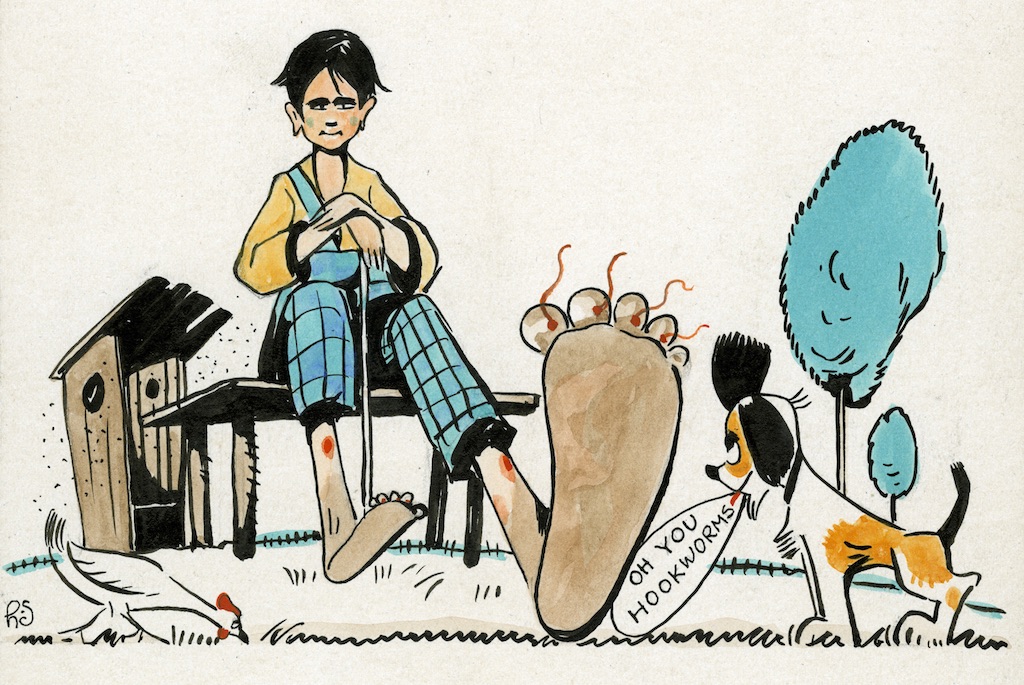23 July 2018
The “Lazy” Southerner: Sloth or Anemia?
Posted by Shane Hanlon
This is part of a series of posts from our own Shane Hanlon’s disease ecology class that he’s currently teaching at the University of Pittsburgh Pymatuning Laboratory of Ecology. Students were asked to write popular science posts about (mostly) wildlife diseases. Check out all the posts here.
By Kausthubha Yaratha
Since the postbellum period, Americans south of the Mason Dixon line have been widely stereotyped as lazy and unmotivated. Academics of the 20th century even pondered if this trope was a reflection of the genetic inferiority of southerners when compared to the “industrious” Yankees of the north. Regardless of the details, many people assumed that this stereotype was couched in truly intrinsic characteristics of the southern Americans. Recent reporting done by Rachel Nuwer, freelance science journalist that has contributed to publications like PBS, New York Times, Scientific American, and Smithsonian, reveals an alternate theory. Researchers have argued that an increase in the prevalence of hookworms in the former Confederate states in the years after the Civil War was significant enough to actually decrease the agricultural output of the South. Data collected from skeletal remains, mortality data, historic economic metrics support this theory. It is estimated that, by 1905, 40 percent or more of people in the south were infected with hookworm.

Cartoon for “The Story of a Boy” by B. Stephany
An infection of hookworm can lead to anemia, which can present itself as lethargy (also described as laziness). The parasite starts in the soil as a free living larvae in the soil. The larvae consumes soil microbes in it’s first two stages. When it reaches its third stage, it migrates to the top soils to increase its chance of being picked up by a human. At this stage, it needs a host to continue its life cycle. When human skin comes into contact with the larvae, it enters the host through a pore. It will use blood vessels and lymphatic vessels to reach the lungs. From there, it will travel up the esophagus and eventually enter the digestive tract. The parasite will attach to the wall of the small intestine where it can gather nutrients. Female hookworms can release eggs here which will exit the host via feces and start the cycle again. Along the way, the host experiences symptoms ranging from nausea to anemia.
In southern states of America, poor farmers walked barefoot and did not have access to central plumbing. This created the perfect maelstrom for a hookworm epidemic. As mentioned earlier, nearly 4o percent of people living in the southern states during the antebellum period were infected with hookworm. Economic productivity was low, and this phenomena helped to establish the stereotype of the “lazy southerner” in the American psyche. Though not founded in scientific observations, the prejudice against southern Americans can be traced back to the widespread infections of hookworm.
Source:
http://www.pbs.org/wgbh/nova/next/nature/how-a-worm-gave-the-south-a-bad-name/










 The Plainspoken Scientist is the science communication blog of AGU’s Sharing Science program. With this blog, we wish to showcase creative and effective science communication via multiple mediums and modes.
The Plainspoken Scientist is the science communication blog of AGU’s Sharing Science program. With this blog, we wish to showcase creative and effective science communication via multiple mediums and modes.